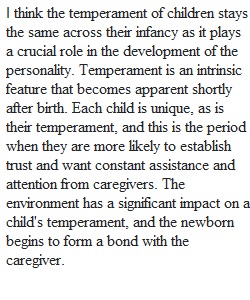


Q Do you think that a child will exhibit a consistent temperament across their infancy? Or is the temperament of a child altered by the environment? Use the developmental theories to justify your response. ________________________________________ Task 1: Create a new discussion topic on or before the required date/time by clicking the **REPLY HERE** post from your instructor. Develop a substantive main thread addressing each part of the prompt in full. Remember, APA format is primarily used in the Social and Behavioral Sciences. For more information about APA Style, please review the APA resources provided within the course. PLEASE NOTE: Once you submit your initial response, you cannot edit or delete posts, so make sure you fully develop your substantive response before posting. Task 2: After you have created and posted your initial response, you will need to respond to a minimum of 2 peers. Think of your responses in terms of a contribution to an ongoing dialogue. Also be sure to incorporate what you have learned from the weekly reading material and from your own real-world experiences. The Critical Thinking Discussion Forum Rubric can be accessed by viewing the course rubrics.
View Related Questions